I did not decide to live in Italy out of passion for the fine arts or for its pleasant climate, but for political reasons. At the time of the martial law on 13 December, 1981, together with my two small children I was in Warsaw, waiting for the return of my husband Jacek from Rome, scheduled for the following day. We were both involved in the activities of, associated with the Committee for Workers’ Defense, underground Nowa publishing house, the consequence of which was questioning, detention and searches experienced by us and our family. Our colleagues and friends were interned or hiding. My husband in the event of return was threatened with internment, so although phones did not work, through friends journalists abroad we were able to communicate and decided that he would stay in Italy, and I would apply for a passport. Jacek was one of the founders and the first chairman of the Committee of Solidarity with „Solidarity”, formed in Rome in collaboration with the federation of Italian CGIL-CISL-UIL trade unions. Thanks to a cooperation contract with a famous Italian architect, I managed to get a passport to travel with children to Rome.
In April 1982 I left gray, very sad communist Warsaw to sunny Caput Mundi, but then I didn’t enjoy the sun because it was forced, unwanted emigration.
The Italian opposition
The first years were a difficult struggle for existence, there was not much time for art. The collaboration through the Committee of „Solidarity” with Italian trade unions, institutions, political parties supporting „Solidarity” and the opposition in Poland during the martial law was a natural continuation of the underground activities in Poland. I received orders to design posters and placards that were printed in large quantities and hung in various parts of the Italian peninsula, mostly in Rome. They reminded Italians that far behind the Iron Curtain there was Poland, suffering, poor, but determinedly fighting for its freedom, independence, democracy. My small children, looking at the advertising column near the playground and carousel, cried out: „Look, Mom, our posters are hanging!”


In 1985, UIL trade union organized a collective exhibition in Rome, which later toured many Italian cities – „100 posters from around the world – »Solidarity« is alive – long live »Solidarity« „. There were as many as 10 my posters, but I could not sign them (at most with my initials), because in those days it was not known how the history would unfold and whether the family in Poland would not suffer because of me.


Recently my Solidarity posters were presented on different exhibitions organized in Italy (e.g. „The tissue paper – the second circuit” at the Polish Institute in Rome and „Solidarity” in the documents of Feltrinelli Foundation”
in Milan and Rome) and in Poland (e.g. „The end of Yalta” at the Karta Center and „Turn off the system. Relay for freedom. 1976-1989” in Warsaw). In Italy I handed over the posters to Feltrinelli Foundation, which gathers the largest outside Poland collection of documents on „Solidarity”, and in Poland – to Karta Center.
Graphic works
My first project realized in Italy I owe to invaluable Father Adam Boniecki. As the director of the Polish edition of „L’Osservatore Romano” he ordered from me a poster advertising the magazine in Polish parishes around the world. It was the first work in my Italian portfolio, empty for several months, as I did not bring any of my achievements from Poland, because I had to pretend that I was leaving only for four months. The works which I was most proud of were printed in the underground Nowa publishing house, so I preferred not to risk smuggling them when I traveled with children. Twenty years later for the activities for the underground publishing house I was awarded the Order of Merit to Culture by the Minister of Culture and National Heritage.
It was not easy, but eventually I managed to establish professional contacts in the field of the applied graphic design, mostly publishing design. Italians in those years, in spite of their great kindness and support for „Solidarity”, were not open to cooperation with foreigners from the East, they treated us with disbelief, doubted if we were able to work on a good level. This was due to their complete ignorance of the world behind the Iron Curtain, the vision of the white bears roaming through the streets of Warsaw was widespread.
I only started learning Italian, but fortunately my profession of a graphic designer is one of the few that can be practiced without good knowledge of the language. The graphic language is almost universal, though in different countries and in different environments some graphic signs, however, have different meanings. I had to learn how to adapt my art education from the Warsaw Academy of Fine Arts to the tastes of the Italian public, and particularly to the requirements of customers ordering my projects. In Italy in those years too original, too bold solutions, were not too willingly accepted. We in Poland were accustomed to the fact that what is important is an idea; that you have to offer something intelligently contrived, something innovative, something that gives food for reflection, paying less attention to aesthetics. Italian clients think conversely: the design should not make the recipient tired, while the aesthetics of the design is always important. I had to adapt, but I tried hard to find such customers who were interested in the original proposals and a few times I was lucky to reach the appropriate environment. In the 1980s, at the request of the Lithuanian Embassy to the Holy See, I designed posters calling for religious and political freedoms in Lithuania. At that time the Lithuanian state did not exist, Lithuania was a Soviet republic, only the Vatican still honored the independent Republic of Lithuania as prior to 1940. Realization of projects for the underground Solidarity, or enslaved Lithuania gave me a sense of usefulness of my work.
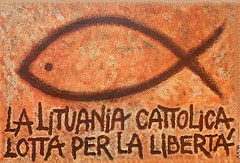

In the 1980s, at the request of the Lithuanian Embassy to the Holy See, I designed posters calling for religious and political freedoms in Lithuania. At that time the Lithuanian state did not exist, Lithuania was a Soviet republic, only the Vatican still honored the independent Republic of Lithuania as prior to 1940. Realization of projects for the underground Solidarity, or enslaved Lithuania gave me a sense of usefulness of my work.
I cooperated with Italian publishing houses, designing covers of books and magazines, layouts of magazines and books, advertising and information materials.
An interesting thing for me was to work for religious publications, such as „Messaggero di Sant’Antonio” in Padua, „San Francesco Patrono d’Italia” from the Basilica in Assisi or for the Fatebenefratelli monastery in Rome. These are very important centers of the Catholic and ecumenical culture, running broad publishing activities, directed to the whole world. I also had the honor to design for CEI – Italian Episcopal Conference. My posters and brochures were in all Italian parishes.
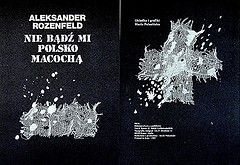

In Padua I could take the experiment of designing a series of religious publications without reference to the figurative tradition of the Christian art.
Referring to the theory and practice of the twentieth century art, I was building with the color and form the mood corresponding to the content of individual topics. With great satisfaction I designed a series of book publications and many book covers and dust jackets for books and magazines. These are the projects that I like very much, because they are religious, liturgical publications, books on the spiritual life and prayer. And although they were published were often in very high volumes, fortunately nobody required from me a purely illustrative approach. At this point the world of religion and the world of art came closer to each other. My design became very painterly and spiritual. Made with different techniques, characteristic of contemporary art, the abstract compositions were received with great interest as something completely new in the environment.
In 1987, me and my husband met Alek Rozenfeld, who trying to re-emigrate from Israel to Poland, stopped in Rome. To publish poems of the poet-wanderer ( „Poland, do not be a stepmother to me”) we established with my husband a tiny publishing house PSIK editore. We were interested not only in Polish affairs; for example, in cooperation with other publishers we published in Italian, French and German languages memories of the famous Polish Himalaya climber Jerzy Kukuczka
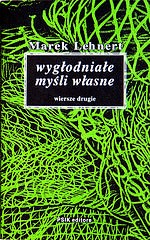

We also dealt with publication of religious texts in Old Church Slavonic language, intended for smuggling into the Soviet Union. All our books I developed graphically on my own, I also made the illustrations. I also designed with great pleasure poetry books for PSIK (I did it also for Nowa publishing house, for instance Kazimierz Wierzyński’s „Crosses and swords”). One of the poetry books issued by us, Marek Lehnert’s „Hungry own thoughts”, was exhibited in 1998 at the exhibition „Polish Book Art” accompanying the International Book Fair in Warsaw, Krakow and other cities.
Ecoreliefs
In the 1990s I began to create „ecorilievi” – ecoreliefs. By combination of the word relief with „eco”, associated with ecology, I wanted my works to be named with one word, without long explanations. Created by me objects-items-artifacts, although they do not belong to the aplied art, are designed, so they are the result of specific processes of analysis and synthesis. I paint, but it is not painting in the traditional sense of the word, my compositions are three-dimensional, but calling them the sculpture would not be accurate. To avoid complicated translations, I came up with my own name for my technique: ekoreliefy (in Polish), ecorilievi (in Italian) and ecoreliefs (in English). In Italian eco means not only „environment”, but also „echo”. Ecoreliefs are ecological and they are an echo of their own past.


Ekoreliefy powstają z idei zachowywania i ponownego wykorzystywania niektórych przedmiotów poprzez przekształcanie ich w dzieła sztuki. Inspirowane naturą, są naturą przetworzoną artystycznie.
Ich geneza wiąże się z moim projektowaniem graficznym: dla wydawnictwa Edizioni Messaggero Padova miałam kiedyś zaprojektować okładkę do książki religijnej dotyczącej Wielkanocy. Wpadłam na pomysł, żeby projekt tej okładki namalować na kawałku drewnianej deski, ponieważ miałam takie skojarzenie: Wielkanoc – drewno Krzyża opowiadające o Wielkiej Nocy. Ten pomysł rozwijałam w innych projektach graficznych. Aż kiedyś w wolnej chwili zajęłam się taką starą deską nie w celu realizacji jakiegoś zamówienia, lecz dla siebie. I odkrył się przede mną fascynujący eko-mikrokosmos…
Twórczość, czyli odzyskiwanie
Moja twórczość jest odnajdywaniem i składaniem różnorodnych elementów otaczającego mnie świata. Z nich powstają nowe formy – ekoreliefy, czyli kompozycje plastyczne będące „artystycznym recyklingiem”. Pracuję, tworząc poszczególne ekoreliefy i zestawiając je w cykle: „Martwa Natura”, „Ciemna Strona Rzeczy” i „Jasna Strona Rzeczy”, „Second Hand Collection”.
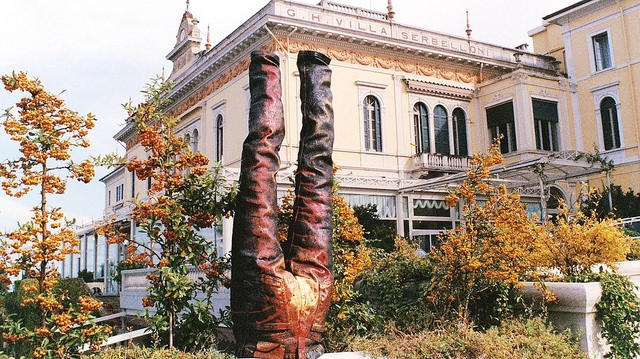

„Second Hand Collection” to cykl ekoreliefów wykonanych z usztywnionych i zastygłych części garderoby, używanych przeze mnie, moją rodzinę i przyjaciół w różnych okresach życia. Dzięki zabiegom artystycznym stare ubrania stają się pięknymi unikatowymi przedmiotami, ale pod warstwami farb nadal tętni w nich poprzednie życie. Zamiast je wyrzucać na śmietnik, próbuję tchnąć w nie nowe życie. Nie ma to nic wspólnego z modą. Uważam ubrania za moją drugą skórę. Eksperymentując na własnej skórze maluję swoje wspomnienia, realizując coś w rodzaju pamiętnika. Jestem wewnątrz i patrzę na siebie z zewnątrz. Moje życie wewnętrzne i życie zewnętrzne przeplatają się i rozdzielają. To dla mnie bardzo ważny rytuał. Specjalny sposób powrotu do siebie. Ubrania, które kiedyś nosiłam, teraz noszą w sobie cząstkę mnie. To moja osobista refleksja nad pamięcią i przemijaniem. Te prace mówią też o sprawach bliskich emigrantom zapuszczającym korzenie w nowym życiu.


Na wielu moich wystawach pokazywałam instalację „Walizka” z cyklu „Second Hand Collection”. Stara, sfatygowana walizka mojej babci. Stawiam ją na podłodze otwartą, jakby w trakcie pakowania lub rozpakowywania. Panuje w niej chaos, ale przedmioty znajdujące się w niej są tylko pozornie przypadkowe. Stara koszulka podziemnego wydawnictwa Nowa, znaczek Solidarności, peerelowski paszport, z którym przyjechałam do Włoch, moje zdjęcie z malutkimi dziećmi, zdjęcie naszego ukochanego kota. Ubrania, które nosiłam w różnych ważnych momentach życia. Porozrzucane kostki domina, puzzle. Zielony, biały i czerwony – jak włoska flaga i – po części – jak polska. Ta walizka zawiera fragmenty opowieści z trzydziestu lat mojego życia. Jest w niej i moja polskość, i moja włoskość, które się przenikają. Wyjeżdżając przed laty z Polski do Włoch, zapakowałam warszawskie życie w walizkę; później, wracając z Rzymu do Warszawy, dorzuciłam do walizki wiele wspomnień.
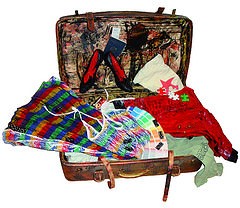

Często fotografuję ekoreliefy poza moją pracownią czy salami wystawowymi galerii. To mój pomysł na street art. Wywożę ekoreliefy na spacer, szukam dla nich odpowiednich miejsc. Obserwuję, jak ekoreliefy współgrają z różnymi pejzażami, czy do nich pasują. Patrzę na reakcje przypadkowych przechodniów i zastanawiam się za Arystotelesem,
read more...
czy to sztuka naśladuje naturę, czy może natura naśladuje sztukę, jak twierdził Oscar Wilde. Pokazuję tymi fotografiami, jak życie splata się ze sztuką, a sztuka łączy z życiem. Jestem przekonana, że ulica miasta, starożytne ruiny, przydrożne drzewo czy wiejski płot są właściwym miejscem do pokazywania moich prac. Miejsce uzupełnia ich treść, zwiększa sens ich powstania.
Grazie per Roma
Są w Rzymie miejsca, gdzie ludzie umieszczają tabliczki z podziękowaniem za doznane łaski. Per Grazia Ricevuta, P.G.R. Ja mieszkałam w pobliżu takiego muru przy Largo Preneste i wiele razy, niecierpliwiąc się w ulicznym korku, podziwiałam tę intrygującą kompozycję z ludzkich uczuć i potrzeb. Myślałam o sile wyrazu street art – sztuki ulicy i o tym, że z czasem Rzym stał się moim miastem


The ecoreliefs are created out of the idea of preserving and re-using some objects by transforming them into works of art. Inspired by nature, they are artistically processed nature. Their genesis is associated with my graphic design: I was to design for the publishing house Edizioni Messaggero Padova a cover for the religious book on Easter. I had the idea to paint the design of the cover on a piece of a wooden board, because I had such an association: Easter – the wood of the Cross telling about Easter. I developed this idea in other graphic designs. And at some point of time I started to work on such an old board not because of any order, but for myself. And I discovered in front of me a fascinating eco-microcosm …
Creation, i.e recovery
TheMy work is a discovery and putting various elements of the world around me together. This way, new forms arise – ecoreliefs, i.e. plastic compositions that are „artistic recycling”. I work to create individual ecoreliefs and put them together in cycles: „Still Life”, „Dark Side of Things” and „Bright Side of Things”, „Second Hand Collection”.


„Second Hand Collection” is a series of ecoreliefs made from stiffened and congealed pieces of clothing used by me, my family and friends in different periods of our lives. Thanks to the artistic effort old clothes become beautiful unique objects, but beneath the layers of paint they still pulsate with their previous lives. Rather than throwing them away in the trash, I try to breathe new life into them. There is nothing in common with fashion. I find clothes my second skin. Experimenting on my own skin, I paint my memories, creating a kind of a diary. I am inside and I look at myself from the outside. My inner life and outer life are intertwined and separated. It is for me a very important ritual. A special way back to myself. Clothes that I used to wear once, now contain a part of me. It’s my personal reflection on memory and transience. These works also tell about issues close to immigrants putting down their roots in a new life.


At many of my exhibitions I showed the installation „Suitcase” from the „Second Hand Collection” series. An old, battered suitcase of my grandmother. I put it open on the floor, as if it was being packed or unpacked. There is chaos inside, but the objects in it are only apparently random. An old underground Nowa publishing house t-shirt, Solidarity post stamp, the communist passport which I came to Italy with, a picture of me with my small children, the photo of our beloved cat. The clothes that I wore in various important moments of my life. Scattered dominoes, puzzles. Green, white and red – as the Italian flag, and – in part – as the Polish one. This suitcase contains excerpts of the stories of thirty years of my life. There is in it both my Polish, as well as my Italian character, which interpenetrate each other. Leaving years ago Poland for Italy, I packed my Warsaw life in a suitcase; later, returning from Rome to Warsaw, I added to the suitcase a lot of memories.


I often take photos of ecoreliefs outside my studio or gallery exhibition halls. It is my idea of street art. I take ecoreliefs for a walk, look for places appropriate for them. I watch how ecoreliefs interact with different landscapes, if they fit them. I look at the reactions of passers-by and following in the footsteps of Aristotle, I wonder whether it is art that imitates nature, or perhaps it is nature that imitates art, as Oscar Wilde claimed. I show with these photos how life is intertwined with art, and how art connects with life. I am convinced that the city street, ancient ruins, a roadside tree or a rural fence are the right places to show my works. The place complements their content, increases the sense of their creation.
Grazie per Roma
In Rome there are places where people put plates thanking for experienced grace. Per Grazia Ricevuta, P.G.R. I lived in the vicinity of such a wall at Largo Preneste and many times, impatient in heavy traffic, admired this intriguing composition of human feelings and needs. I thought about the power of expression of the street art and that with time Rome became my city. So I decided to join the P.G.R. wall as an artist and I put there my word of thanks. First, I hung two wooden ecoreliefs, one saying „Grazie per Roma” ( „Thank you for Rome”) and the other one saying „Thank you” in Polish. The plate with the Polish inscription disappeared after a few weeks, maybe it was just too poorly attached, and maybe the incomprehensible inscription was disturbing for somebody. Later, I put there a bigger ecorelief dedicated to Rome „a Roma” (double meaning: „for Rome” and „in Rome”). I recently checked; it still hangs, surrounded by newer P.G.R. plates, because life in the Eternal City goes on.
In Italy, I had individual and collective exhibitions in different places, often unusual and extremely picturesque. In fact, I like exposing in traditional galleries the least, I prefer showing ecoreliefs at locations closer to real life. My first Italian exhibition took place in 1985 in Vallinfreda, a small mountain summer resort with less than 200 permanent residents and 4,000 summer visitors. The authorities of the village, organizing various activities, more or less cultural, on the occasion of Ferragosto holiday (15 August), made available to me for free (then surprisedly I learned that the artist almost always has to pay for the rent of the exhibition hall) an empty shop at the main square. It turned out that I was supposed not only to organize all the exhibition, but also to stay there all the time during the exhibition, keeping a lookout for the works and answering to visitors’ questions. It was a completely new experience, in Poland exhibitions were organized in a different way. To my great surprise, my little exhibition was visited probably by all the people staying at the time in the town, I was asked many questions, I listened to various comments, several works were bought. Exhibitions in Italy, in this respect, resemble fairs, which is widespread and later I also repeatedly participated in similar events. I also had my works exhibited in Tivoli, Carsoli, in the castle of Santa Severa, in Turin, Milan, Florence, at the beautiful Garda Lake, in the prestigious Villa Serbelloni in Belaggio at Como Lake, in many different places in Rome. My first exhibition in Rome took place in the feminist bookstore in Trastevere. I exhibited in the non-existent today art gallery Navona 42 on the famous Piazza Navona. I took part in a multi-ethnic festival „Sconfinata … mente” and „MIGRA-ART 2005” in Rome. There were exhibitions of Polish artists, for instance, in the church of San Andrew’s at the Quirinale and at the premises of two Polish embassies (in Vatican City and in Rome). My works were also exhibited several times at the Polish Institute in Rome and in the Polish consulate in Milan.
A thousand layers of Rome
TheMy work is a discovery and putting various elements of the world around me together. This way, new forms arise – ecoreliefs, i.e. plastic compositions that are „artistic recycling”. I work to create individual ecoreliefs and put them together in cycles: „Still Life”, „Dark Side of Things” and „Bright Side of Things”, „Second Hand Collection”.A thousand layers of Rome
Although the first few years I felt a great nostalgia typical of emigrants, and my life did not quite resemble dolce vita, I got to love my second homeland. Italy always fascinated me and I have not cured myself of it for over thirty years of my stay here. The more places I watch in the world, the more I feel the beauty of this country. The beauty of nature and the material beauty created by humans. Italy, especially Rome, shaped me as an artist, complemented my Polish artistic education. I understood that the role of Beauty in art is valid and cannot expire. The contemporary art loses a lot resigning from it. The contemporary Italian visual artists shock and scandalize but are not afraid of Beauty, which probably they have in the genes.
For me, the most magical city in Italy is Rome which is a geological cross-section of the culture of centuries. Beautiful and inspiring to create Beauty. This is a great millefoglie cake: layers of life combined with layers of art. Ancient, medieval, and later layers of Renaissance, Baroque … The contemporary life of the great metropolis pulsates with life in them. The present and the past merge together. Me and my ecoreliefs somewhere in the middle, like tiny raisins.
I have Italy encoded in my Polish DNA. When I worked in Padua, among others for the Basilica of Saint Anthony, my grandmother told me that in the basilica there is a Polish chapel, where in 1558 Erazma Kretkowski, Castellan of Gniezno and a traveler, was buried. And that he was our distant ancestor …
In recent years I live mainly in Warsaw, but over 30 years’ Italian roots hold me firmly in the Apennine Peninsula. I have two homelands, two passports. Sometimes I dream about Rome, sometimes about Warsaw. I think, speak, dream in Polish, but I create in Italian.
www.mariapalasinska.com
https://www.flickr.com/photos/mariapalasinska/sets
Postanowiłam więc dołączyć się do ściany P.G.R. jako artystka i umieściłam swoje podziękowanie. Najpierw zawiesiłam dwa drewniane ekoreliefy, jeden z napisem „Grazie per Roma”, („Dziękuję za Rzym”) i drugi z „Dziękuję” po polsku. Tabliczka z polskim napisem zniknęła po kilku tygodniach, może po prostu była za słabo przyczepiona,


a może komuś przeszkadzał niezrozumiały napis. Później umieściłam tam większy ekorelief zadedykowany Rzymowi „a Roma” (podwójne znaczenie: „Rzymowi” i „w Rzymie”). Niedawno sprawdzałam; jeszcze wisi, otoczony nowszymi tabliczkami P.G.R., bo życie w Wiecznym Mieście toczy się dalej.
We Włoszech miałam wystawy indywidualne i zbiorowe w różnych miejscach, często nietypowych i niezwykle malowniczych. Właściwie najmniej lubię wystawiać w tradycyjnych galeriach, wolę pokazywać ekoreliefy w miejscach znajdujących się bliżej prawdziwego życia. Moja pierwsza włoska wystawa miała miejsce w 1985 roku w Vallinfredzie, małej górskiej miejscowości letniskowej z niespełna 200 stałymi mieszkańcami i 4000 letników. Władze miasteczka, organizując różne atrakcje mniej lub bardziej kulturalne z okazji święta Ferragosto (15 sierpnia), udostępniły mi za darmo (wtedy ze zdziwieniem dowiedziałam się, że artysta prawie zawsze musi płacić za wynajęcie sali wystawowej) pusty lokalik sklepowy przy głównym placyku. Okazało się też, że nie tylko mam sama zająć się urządzeniem tej wystawy, ale że mam stale przebywać tam w czasie jej trwania, pilnując prac i odpowiadając na pytania zwiedzających. To było zupełnie nowe doświadczenie, w Polsce wystawy organizowało się inaczej. Ku mojemu wielkiemu zaskoczeniu, moją małą wystawę zwiedzili chyba wszyscy przebywający w tym czasie w miasteczku, zadawano mi wiele pytań, słuchałam różnych komentarzy, kupiono kilkanaście prac. Taki jarmarczny charakter wystaw jest we Włoszech bardzo rozpowszechniony i później też wielokrotnie uczestniczyłam w podobnych imprezach. Wystawiałam w Tivoli, Carsoli, na zamku w Santa Severa, w Turynie, Mediolanie, Florencji, nad pięknym jeziorem Garda, w prestiżowej Villi Serbelloni w Belaggio nad jeziorem Como, w wielu różnych miejscach w Rzymie. Moja pierwsza rzymska wystawa miała miejsce w feministycznej księgarni na Zatybrzu. Wystawiałam w nieistniejącej już dziś galerii sztuki Navona 42 przy słynnym Piazza Navona. Brałam udział w festiwalu multietnicznym „Sconfinata…mente” i „MIGRA-ART 2005″ w Rzymie. Były wystawy zbiorowe polskich artystów, np. w kościele San Andrea przy Kwirynale i w siedzibach obu polskich ambasad (przy Watykanie i w Rzymie). Moje prace wystawiałam również kilka razy w Instytucie Polskim w Rzymie i w polskim konsulacie w Mediolanie.
Tysiąc warstw Rzymu
Chociaż przez pierwsze lata czułam wielką nostalgię typową dla emigrantów, a życie moje niezbyt przypominało dolce vita, pokochałam moją drugą ojczyznę. Włochy fascynowały mnie od zawsze i nie wyleczyłam się z tego w ciągu trzydziestoletniego pobytu. Im więcej miejsc oglądam w świecie, tym bardziej odczuwam piękno tego kraju. Piękno natury i piękno materialne stworzone przez ludzi. Włochy, a zwłaszcza Rzym ukształtowały mnie jako artystkę, uzupełniły moje polskie wykształcenie artystyczne. Zrozumiałam, że rola Piękna w sztuce jest aktualna i nie może ulec przedawnieniu. Sztuka współczesna wiele traci, z niego rezygnując. Współcześni włoscy artyści wizualni szokują i skandalizują, ale nie boją się Piękna, które zapewne mają w genach.
Dla mnie najbardziej magiczne miasto we Włoszech to Rzym, będący przekrojem geologicznym przez kulturę stuleci. Piękny i inspirujący do tworzenia Piękna. To wielki tort millefoglie: warstwy życia przełożone są warstwami sztuki. Warstwy starożytne, średniowieczne, później renesansowe, barokowe… W nich tętni współczesne życie wielkiej metropolii. Teraźniejszość i przeszłość przenikają się wzajemnie. A ja i moje ekoreliefy gdzieś w środku, jak drobne rodzynki.
Włochy miałam już zakodowane w moim polskim DNA. Kiedy pracowałam w Padwie, m.in. dla Bazyliki św. Antoniego, babcia poinformowała mnie, że w bazylice znajduje się polska kaplica, w której w 1558 roku pochowano Erazma Kretkowskiego, kasztelana gnieźnieńskiego i podróżnika. I że to był nasz odległy antenat…
W ostatnich latach mieszkam głównie w Warszawie, ale ponadtrzydziestoletnie włoskie korzenie trzymają mnie mocno na Półwyspie Apenińskim. Mam dwie ojczyzny, dwa paszporty. Czasem śni mi się Rzym, czasem Warszawa. Myślę, mówię, śnię po polsku i po włosku i tak tworzę.
www.mariapalasinska.com
https://www.flickr.com/photos/mariapalasinska/sets



